Home » 5G Magazine » 5G for Manufacturing | 5G Magazine
5G for Manufacturing | 5G Magazine
Featured articles in this edition
Spotlight Your Innovation in 5G Magazine

- November 5, 2023
Smart Manufacturing uses information and communication technologies (ICT) to manage, design, produce and monitor manufacturing processes. ICT includes a wide range of technologies such as the industrial internet of things (IIoT), cloud & edge computing, big data analytics, artificial intelligence (AI), machine learning (MI), augmented reality (AR), virtual reality, advanced robotics, digital twin, 3D printing (additive manufacturing), and of course industrial connectivity. These technologies enable the manufacturing industry’s goal of digital transformation, improving productivity, quality, safety, and reducing cost. They also help factories reach their sustainability goals by reducing waste and lowering CO₂ emissions.
The role of connectivity in the manufacturing industry is to provide a secure, reliable, and efficient communication network for data flow between machines and devices. There is a range of connectivity options for smart manufacturing. One option is to use Industrial Ethernet. Other options include WiFi or wireless technologies such as 5G or 4G/LTE, which can provide fast, reliable connections for machines and devices in harsh industrial environments.
This article examines the manufacturing industries’ use cases that take advantage of 5G as a connectivity option (predominately in a private network deployment) and one or more technologies such as artificial intelligence, advanced robotics, and augmented/virtual reality edge computing. To determine for which applications the manufacturing industry is leveraging 5G technology, the impact of 5G, and the leading players, we investigated 60 worldwide manufacturing use cases.
Production vs. Trial Use Cases: Out of the 60 use cases utilizing the 5G network, 70 percent of the use cases were already in production and 30 percent in trial mode. Deployment Mode: Enterprises deployed a “private 5G network,” with security as the main incentive in ninety-six percent (96%) of the evaluated use cases. In comparison, enterprises chose public-private 5G combination with network slicing for two use cases. Leading Region & Country: Europe has the most private 5G deployments for manufacturing, with German enterprises leading the way. Who owns spectrum? Fifty-three percent (53%) of the enterprises used spectrum from telecommunications service providers. In comparison, forty-seven percent (47%) utilized the enterprise vertical spectrum.
1. Remote inspections, troubleshooting, and training with AR/VR

Augmented and Virtual Reality in conjunction with 5G can automate several operational tasks for the enterprises such as field inspections, remote assistance for troubleshooting and repair, and remote training. With 5G, you have a high bandwidth that will allow you to quickly transmit large amounts of data. The high bandwidth is important for transmitting video, images, and augmented reality content from the field to a supervisor or expert for analysis.
With augmented reality, you can overlay the information in the real world, making it easier to see what is going on. This could be used to show the location of a gas leak, for example. With Virtual Reality, you can create a virtual world that can be used for training or inspection. For example, you might build a virtual model of a plant and examine it for any issues.
Remote Inspections and Troubleshooting
Field inspections of manufacturing plants require a significant amount of technical information about the plant equipment and require considerable expertise from the field technician. Additionally, operators have a limited number of technicians who have in-depth knowledge of the plant equipment, processes, and operations for troubleshooting an issue.
With 5G technology, operators can equip the technicians with augmented reality devices to assist the field technicians with less technical expertise through an augmented display when performing maintenance and repair activities.
For example, Ericsson has been experimenting with augmented reality (AR) overlays in its Tallinn, Estonia smart factory to troubleshoot and repair electronic boards. They found that searching for information from documents, manuals, and schematics takes up roughly 50% of the total time required to troubleshoot circuit boards.
“…searching for information takes up 50% of total time required for troubleshooting…” As a result, the typical fault detection time with AR inspection may be reduced by 15%.
There will also be fewer component replacements, resulting in energy savings and less chemical use, waste, and scrap.
Remote Training
Using immersive and interactive augmented and virtual reality-based training solutions, over 5G connectivity can give distance learning trainees the same real-world experience as if they were on-site with the trainer. It improves learning retention compared to the conventional training method.
Virtual reality can be used to help and speed up training for procedures that are impossible, difficult, or inconvenient to work with the actual equipment for example, if you want to train individuals before the equipment arrives at the site or if they are in a sterile location and don’t want people to change clothes for training. It also eliminates the cost & time for the trainers and trainees to travel to the training center & related expenses. In addition, the recorded training content can be reused for training, product assurance, compliance, and the potential redesign of solutions.
2. Asset Management: Tracking and Traceability
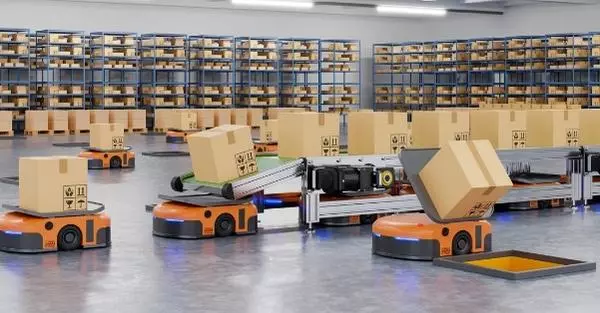
A range of tools and assets are utilized by technicians & engineers as a part of the overall manufacturing process. The key issues that operators face include:
- Lack of dedicated tool storage facilities
- Tools susceptible to loss or damages, especially when being stacked one on top of another
- Tool utilization & maintenance schedules are not monitored accurately, causing costly quality issues to the final product.
- Often technicians/engineers tend to leave tools where they’ve last been used, which in turn makes it difficult for others to find them when needed.
- Even if a central storage facility is created, it is difficult to enforce compliance in terms of returning tools to this central point after use.
The result is that a significant amount of resource time is wasted searching for and locating tools when required, which can be very unproductive in terms of loss of time and a cost to the business. Asset tracking and traceability can eliminate the unproductive time spent on searching for tools. 5G capable sensors (IoT devices) can be installed on in-factory and in-transit assets (i.e., materials, tools & final products). The data from the sensors can be transmitted within the private/public 5G network, analyzed, and visualized via edge devices such as mobile handsets & centralized management systems. Tracking and traceability of assets with sensors help the manufacturing industry to save time on unproductive tool location searches, reduce costs associated with outdated material disposal, and increase tool utilization.
3. Industrial automation with Automatic Guided Vehicles (AGV)
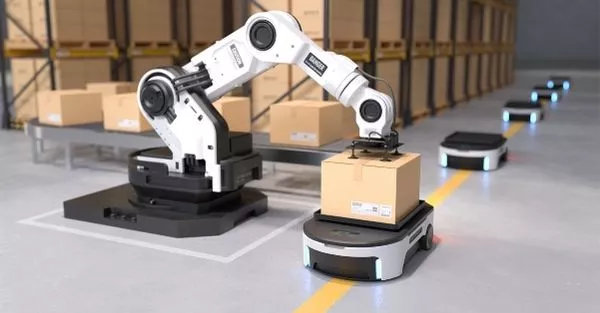
With the rise of Industry 4.0 and the Internet of Things (IoT), more and more enterprises are turning to Automatic Guided Vehicles (AGVs) to automate material transport and tasks in their smart factories. The AGV (e.g., Forklift AGVs, towing AGVs, unit load handlers, heavy burden carriers, autonomous mobile robots) is a vehicle that moves autonomously, meaning it requires no human input or control beyond the initial programming and design.
They travel along designated long lines or wires on the floor or utilize radio waves, magnets, vision cameras, geoguidance, or lasers for navigation. AGVs are used extensively in manufacturing and warehousing facilities to transport materials and products from one point to another, loading and unloading trucks or trailers, and moving stock around in the warehouse. Many smart factories use and maintain a fleet of AGVs. Still, to get the most out of them, enterprises must first digitize the manufacturing environment and connect the automobiles before capturing and combining all that data.
AGV information combined with the enterprise’s systems can capture the required data, create insights, reduce uncertainty, and support decisions. One of the key challenges with handling numerous AGVs in the manufacturing facility is connectivity. AGVs have traditionally relied on WiFi or RFID for communication between vehicles and control systems. While these technologies work well in many applications, they run into issues in busy or congested environments where multiple AGVs try to communicate with each other or with a central controller. When there are WiFi shadows in the manufacturing facility, and you lose connection with your equipment when a problem is about to happen, the gains made by investing in the AGVs can be rapidly lost.
The 5G connectivity has solved the challenge of connecting AGVs with WiFi. 5G connectivity easily scales to connect a large number of factory devices, including sensors and machines. Additionally, it provides high bandwidth, low latency, and complete coverage across the factory premises ensuring smooth operation of AGVs.
4. Industrial Automation for improving productivity

Industrial automation has revolutionized the manufacturing process. It allows for greater efficiency and precision in the production of goods. Additionally, it helps to minimize human error, which can often lead to defects in products. Automation also enables factories to operate around the clock, increasing their production capacity. The term describes a broad category of process automation that runs on industrial equipment. Control systems are often used with technologies like IoT sensors, AI vision cameras, and autonomous robots to manage repetitive tasks.
The transition to 5G connectivity will allow for broader adoption of industrial automation. For example, 5G’s low-latency wireless communications will simplify real-time machine monitoring and controls, providing industry leaders more insights into their factory operations. An industrial plant may use 5G to connect AI vision cameras along the production line to examine products and improve efficiency and productivity. Capturing real-time data from industrial equipment and production processes would allow factories to see their production patterns in much greater depth.
They can then identify the appropriate manufacturing process sequence and maximize flow by using this information, thereby reducing waste and improving production cycles. Our recent conversation with a few automobile manufacturers revealed some of the areas in which they are already using intelligent automation capabilities within their private 5G deployments:
- Cloud-based control of autonomous transport systems
- Condition monitoring for the shop floor equipment
- Augmented reality and effective communication between robotics systems and the control center
- Transfer in real-time, large quantities of test data from vehicles to the data center for more efficient data collection
- Product life cycle and process automation
- Supply chain asset management
The future of industrial manufacturing and logistics will be increasingly reliant on automation and robotics. Factories and warehouses will become smarter, with more efficient systems in place to manage the flow of goods. This will result in a more streamlined and cost-effective process, making it easier for businesses to meet consumer demand.
5. Real-time insights from field devices for decision-making
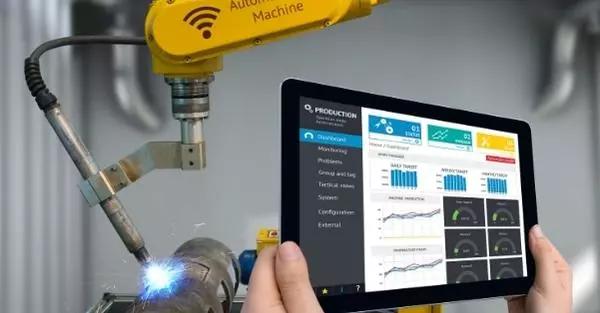
Field devices are sensors and actuators used for gathering real-time data in a manufacturing plant. They can be classified according to their functions, including measuring parameters such as temperature, pressure, flow, level, and vibration, detecting objects and controlling processes. They are an important part of the Industrial IoT infrastructure and play a critical role in gathering decision-making data. Traditionally, field devices are connected to a local area network (LAN) or the internet through industrial gateways.
As also noted for AGVs, the key difficulty is connectivity across millions of field devices throughout the manufacturing plant. Both wired and wireless connections have limitations in terms of scaling up to connect a large number of field devices, in addition to latency and interference. 5G network’s massive bandwidth, reliability, and scale to support up to one million devices per square kilometer enable enterprises to gather real-time data from the field devices across the manufacturing plant.
The data collected from the field devices is processed and analyzed for real-time insights via edge computing. This allows enterprises to make rapid decisions and take action on issues as they arise, supporting quality, safety, and efficiency in the manufacturing plant.
6. Remote Monitoring
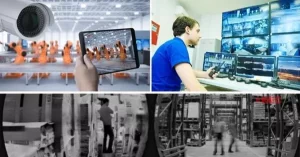
Remote monitoring is the capability to monitor and control production assets from a remote location. This can be done through sensors that are installed in the plant or by using information technology tools to monitor the performance of the plant. Normally, operators must be physically present at the factory to monitor and control the production process and assets. But because of remote monitoring, operators do not need to be on the factory floor. They can use software systems to keep track of operations in real-time. This allows operators to find and manage assets, obtain immediate insights, and adjust the equipment to increase safety, productivity, and quality.
A use case being explored by a leading service provider is to implement a real-time video monitoring system within their dedicated private 5G network at its manufacturing plant. The private 5G network will transmit 4K Ultra HD-based live-streaming videos from numerous devices, such as cameras positioned throughout the plant. The video will be sent to a remote maintenance system, which the control center will utilize to conduct site inspections. This will eliminate the need for technicians to visit remote areas and enable early detection of failures, increasing productivity, efficiency, and safety at the plant.
In another use case, a leading supplier of power and automation products is exploring the remote monitoring of its manufacturing facilities which operate 24/7 and require continuous monitoring. The remote monitoring and control of different processes would enable them to improve security, efficiency, and quality aspects. The 5G network’s guaranteed level of service makes it perfect for time-critical remote monitoring and control operations from a centralized command center. This makes it an ideal solution for manufacturing companies that need to keep track of their production line process and ensure that everything is running smoothly.
7. Predictive and Preventive Maintenance
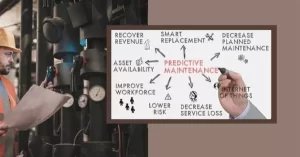
Predictive maintenance is the anticipation of problems that might occur in a machine or system. In predictive maintenance, arrays of sensors (IoT devices) periodically collect data on the performance of machines in a smart factory. This data is analyzed to identify any patterns that could suggest a machine is about to fail. This way, maintenance can be scheduled before a machine actually fails, preventing any unexpected downtime.
Preventive maintenance is the implementation of a plan to address those potential problems before they have a chance to cause any damage or failure. It is a critical process that helps ensure the quality and safety of the manufactured products. By conducting preventive maintenance on a regular schedule, manufacturers can catch any potential problems with the equipment before they cause any serious issues.
Additionally, preventive maintenance can help extend the life of the equipment, saving the manufacturer money in the long run. 5G connectivity will improve predictive maintenance capabilities since it provides the required high bandwidth, low latency, high reliability, and scale to collect more real-time data from a wider range of devices that monitor the equipment in the manufacturing plants.
The use of artificial intelligence (AI)-based models and analytics in conjunction with edge computing can help to identify trends and patterns in the data that can be used to make predictions about future failures. The high bandwidth, ultra-reliability, and low latency of 5G networks can help to ensure that data is processed quickly and accurately and also enable remote maintenance.
Our recent conversation with an electronics manufacturer revealed how 5G enables predictive and preventive maintenance and helps them to provide reliable and secure information to their customers in real-time. The 5G network enables real-time machine vision inspections from the start to guarantee the welding quality and the presence of components on its manufacturing lines. In addition, they train algorithms to minimize errors and readjust machines, as required.
They are using 5G technology to regulate the production environment. In particular, it’s being utilized in the controlled manufacture of electronic cards for the aviation sector, where temperature and hydrometric control is necessary to prevent damage. Enterprises can also realize cost savings through the implementation of 5G and IIoT, which allows for continual equipment monitoring. For example, instead of replacing a machine part every few months, the factory can monitor its status and replace it only when necessary.
8. Supply Chain Management

Supply chain management is the process of planning, organizing, and managing the flow of materials and products from supplier to customer. It involves the coordination of activities across a number of different businesses and functions, such as procurement, production, transportation, and distribution. In the context of manufacturing plants, supply chain management is essential for ensuring that the right materials are available at the right time and in the right quantities. It also helps to optimize the production process by minimizing waste and maximizing efficiency.
Today, many supply chain operations are labor-intensive and require a lot of human involvement at many touchpoints (for example, logging when the material arrives, physically transferring pallets, etc.) In this case, there is clearly a need for a network to provide coverage and capacity in the supply chain in order to get near real-time visibility of the whereabouts of products in transit for optimizing the operations.
A 5G network can provide the required bandwidth, low latency, and high reliability that is necessary to support such a requirement. It can also help to reduce the amount of time that is required for data transfer between manufacturing plants and their suppliers, which can be crucial for supply chain management.
For example, if a supplier is running late on a shipment, the plant will be able to notify other suppliers and make the necessary adjustments quickly. Having 5G connectivity integrated into factory equipment will enable fast, automatic replenishment of components and supplies, minimizing delays and increasing productivity as transparency into the supply chain increases.
In short, 5G connectivity can help enterprises with their goal of creating agile supply chains that can adapt to consumer demand while minimizing costs and lead times. The 5G network’s guaranteed level of service makes it perfect for time-critical remote monitoring and control operations from a centralized command center. This makes it an ideal solution for manufacturing companies that need to keep track of their production line process and ensure that everything is running smoothly.
9. Security

One of the key security challenges of manufacturing plants is the potential for cyberattacks. These attacks can cause serious damage to plant equipment and disrupt the production process. In addition, manufacturing plants are also vulnerable to physical attacks, such as theft or vandalism. Manufacturing plants also need to be aware of the possibility of industrial espionage. Corporate spies can steal confidential information about new products or manufacturing processes, which can give their company a competitive edge.
Private 5G/LTE deployments offer manufacturers a way to address some of the security challenges. By deploying a private 5G/LTE network and necessary endpoint security on the factory devices, manufacturers can limit the access to their network and control who has access to their infrastructure. They can detect and defend against threats in the dedicated private 5G network, authenticate the devices trying to connect to the network, and block unauthorized communication in real-time. Additionally, 5G’s can provide a high-quality, real-time video feed for surveillance.
10. Flexible & modular factory
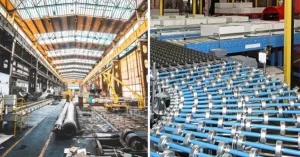
A modular or flexible smart factory is a manufacturing plant where the production process can be easily reconfigured to produce different products. The factory layout can be changed, and new machines and equipment can be added without affecting the rest of the factory. This type of factory is becoming increasingly popular because it allows companies to respond quickly to changes in demand for different products. Instead of closing down the factory and rebuilding it when there is a change in demand, they can just reconfigure the production process.
The flexibility of a modular smart factory also allows companies to produce products in small batches, which is becoming more important as consumers demand more variety in the products they buy. The 5G wireless connectivity can assist with flexible or modular factories by delivering massive bandwidth, low latency, reliable coverage, and scale to connect all industrial devices. In addition, it will provide enterprises with the ability to replace their existing fixed ethernet connections with 5G connectivity, allowing for greater flexibility in production line adjustments and lower initial site investment due to lower cabling expenses.
- March 18, 2024
Lufthansa Technik’s private 5G network for virtual table inspection and Aircraft cabin outfitting
Lufthansa Technik began operating its own 5G campus network based on the Release 15 standard more than two years ago at its Hamburg site, first standalone outside of Asia. This allows them to tackle data-intensive tasks and work more efficiently. We spoke with Dr. Claudius Noack, an IT consultant and technology scout with Lufthansa Industry Solutions, about the use cases, implementation process, reasons behind 5G, using own spectrum, deployment partners, outcomes, outlook, and key points to keep in mind while enterprises are deploying their own private 5G network.
What were the 5G Use Cases implemented by Lufthansa Technik?
We implemented two use cases with 5G technology at Lufthansa Technik’s Hamburg site. The two use cases are in one aircraft hangar and one engine overhaul shop. Both use cases went live in early 2020 (one in Jan and another in Feb).
Use Case 1: Virtual Table Inspection
During an overhaul, aircraft engines are almost entirely disassembled, with each individual part thoroughly inspected separately by Lufthansa Technik’s experts. The old standard process for this so-called “table inspection” called for customers to travel to Hamburg in order to personally attend these part inspections and jointly discuss their sometimes costly repair decisions on-site.
The private 5G network, offering “industrial-grade” reliability, alongside ring-fenced latency and bandwidth performance, now removes the need for customers to physically attend the inspection; instead, they can virtually attend the engine overhauls taking place in Lufthansa Technik’s base in Hamburg via live high-definition video feeds. Customers are guided through the engine shop using a third-party mobile device that provides real-time, high-resolution video streaming with mechanics and engineers.
This allows virtual inspection of dismantled parts enabling joint decision-making about inspected components. We will configure and adapt the network to meet the project’s needs. i.e., accommodate demanding upload and download speeds and adequate computing power to handle the processing requirements of live transmission for remote high-resolution screen inspection calls.
Use Case 2: Aircraft Cabin Outfitting
The focus of this use case was on further streamlining coordination processes even if the requirements are completely different. The idea was to simplify the process of furnishing the aircraft cabins. In the still empty aircraft fuselage, the 3D design data of cabin monuments can now be visualized via augmented reality together with the current installation situation in the aircraft. This enables the technicians to identify necessary adjustments more quickly and discuss the necessary measures with the engineers via video conference.
This would enable technicians to mix office-based digital twins with workshop-based augmented reality to build cabin interiors. This was not possible before launching the campus network, as the transfer of the extensive CAD data required high bandwidths, even inside the parked aircraft. Despite its very positive outcome, this use case was discontinued as planned after the several-month test phase expired.
What were some of the major considerations and the overall procedure?
Finding concrete use cases
In the beginning, is the use case analysis. Lufthansa Technik was very open to possible potential right from the start. So for us, the initial focus was on finding concrete use cases to solve connectivity problems with what 5G was able to offer at that time. We worked closely with the innovation department and strictly sounded out and prioritized according to feasibility and added value.
Decide 5G Technology partner for use cases
The next step was to decide which 5G partner with its technology was most suitable for the use cases. Does the company need the support of a network operator? Or is cooperation with a pure equipment supplier sufficient?
Frequencies: Use existing or apply for own?
Depending on the application, companies are faced with the decision of either relying on the existing frequencies of a network operator or reserving and applying for their own frequencies. If the project depends on constantly high data throughput, the choice should be made to use its own frequencies, which are also particularly secure. However, companies must apply for these frequencies at the Federal Network Agency.
This is a procedure in which external expertise should definitely be obtained. Applicants must provide credible assurance that they need the frequencies and must explain which projects they intend to solve with the technology. This step also involves coordination with direct neighbors and other stakeholders. Overall, this is a lengthy process and can tie up capacity over several weeks. Those responsible should be aware of this at the beginning of the project.
It is important to integrate different contact persons in the company into the project team at an early stage – from IT experts, and electricians to caretakers.
Support during rollout
Finally, support during the rollout of the project is advisable. Without checklists or corresponding experience values, it is possible that a lot of time will be lost, depending on the scope of the use case.
Why 5G?
Both projects have a very high demand for bandwidth for wireless data transmission and require latency constantly below 100ms, which could not be covered adequately by the 4G and Wi-Fi technologies. The public 4G upload rate was often no longer sufficient for high-resolution video streams because public indoor coverage is not often as good as outdoor coverage because of shielding etc. The problem with Wi-Fi is that the connection might drop between access points. The Wi-Fi standard is not designed for a change of location between individual cells, which previously often led to connection terminations.
This results in the video stream dropping out and the customer’s important repair decision is hampered by a sudden lack of transparency. For Wi-Fi 6, we haven’t seen any practical implementation in the past. 5G offers data transmission of up to 10 Gbps compared to a maximum of 1Gbps for 4G/LTE. We achieved low latency of 7ms in the 5G SA network, which is not 1ms – but a lot better than Wi-Fi. At times, the value of latency was higher than 7ms, which is important to note.
When talking about 5G projects, one thing is important to us: There is no “5G for the sake of 5G”
What was the rationale for using your own spectrum?
For both the use cases, we decided to use our own frequencies, the 3.7-3.8 GHz band which German regulator BNetzA is leasing for dedicated enterprise usage in the country. Instead of going to Vodafone Germany for a proto-slice of its 5G network.
This enabled higher security and a completely free configuration, which allows Lufthansa Technik’s own 5G networks to be adapted exactly to the requirements of the respective evaluation projects & use cases, for example in the ratio of upload and download bandwidth.
Our objective was to evaluate 5G technology in general, and not just the providers of it. We want to mainly know what the benefits of 5G will be to our company. These are two completely different use cases, with totally independent networks and hardware. They are being completely managed by our own IT teams. We also used our own antennas and servers for both use cases. As shown below, ‘LH-Technik’, is the network provider in the handset display. This network can only be accessed by Lufthansa Technik.
What has been the outcome of these initiatives thus far? Did 5G live up to the hype?
5G helped with remote inspections during Covid-19 lockdown.
The private 5G networks provide a stable and secure connection for this important use case, which has been live for almost 24 months now. It enables the technicians to consult with airlines on engine maintenance and refit aircraft cabins remotely. 5G SA performs less well than advertised, never hitting the 1ms latency benchmark the market has promised; but 7ms on one side and 9ms on the other, as the firm is managing in Hamburg, is quite good enough. The main thing was to have a highly-reliable, high-quality, real-time video stream – which we can roam with across an 8,000 square metre site. It is the perfect lockdown solution, in terms of travel, logistics, and associated costs; the reduced environmental impact might be calculated, too.
The first call to the customer, and they said, ‘We have never had such a stable, crystal-clear feed, before’. So they were really happy. We thought we might use a big industrial 5G use case like this for 50 percent of inspections, perhaps. But we installed it in January, and Covid-19 came to Hamburg in March, and all travel stopped. So, suddenly, we were doing all inspections remotely.
If we had not set up that network, we would not have been able to do those engine inspections in this manner. 5G kept that use case alive – that is the business case.
- March 18, 2024
Nokia’s digital automation cloud for virtual table inspection use case
Nokia is delivering 5G private wireless network connectivity by deploying the Nokia Digital Automation Cloud (DAC) 5G SA solution for Virtual Table Inspection use case. Nokia DAC is a plug-and-play digital automation platform that can easily scale from a small local deployment to multiple sites of large systems, all managed from the same web portal. The application platform provides high-bandwidth, low-latency, hyper-fast private wireless connectivity and local edge computing, which provides digitalization enablers. Nokia has deployed two indoor 5G small cells.
Remote, high-resolution screen inspection calls for high-bandwidth and low-latency capability to accommodate demanding upload and download speeds as well as adequate computing power to handle the processing requirements of live transmission. Its flexibility is enabling Lufthansa Technik to configure and adapt the network to precisely meet the project’s needs.
Chris Johnson, Global Head of Enterprise, said: “This application captures the essential value of fast, secure 5G private wireless networking to help improve operational efficiency, productivity, and service. It highlights the potential for new ways of working that benefit not only our customers but also the markets they serve.”
Raghav Sahgal, President, Nokia Cloud and Network Services, said: “The pandemic has highlighted the business value of digitalization, with companies that are more advanced in their digital transformation demonstrating greater levels of flexibility and resilience. Through Lufthansa Technik’s pioneering application of private wireless networking, it has illustrated the potential of 5G to improve productivity, and transform the customer experience in even the most challenging circumstances.”
- March 18, 2024
As the manufacturing sector modernizes, facilities increasingly rely on IoT and connected devices. The number of these devices, from sensors to robots to automated machinery, is growing rapidly, increasing business productivity, producing valuable data, and saving on costs. But there are new security risks as well, especially as more manufacturing companies turn to private cellular networks to more effectively run smart and connected factories.
Private cellular – the industry 4.0 enabler
Naturally, the addition of so many devices in such close physical proximity has required additional bandwidth for digital communications. Standard IT networks, including Wi-Fi, are no longer sufficient on their own when there are so many more endpoints that demand connectivity, especially when it comes to moving devices, remote and autonomous machines, analytic needs, and more. Fortunately, private LTE/5G technology has adapted well to addressing these growing connectivity needs. This exciting and affordable technology is enabling the next generation of connectivity that the transition to industry 4.0 demands.
Security challenges …and opportunities
Not only does this technology provide us with the ability to support these emerging technological needs, but it also introduces us to a new era of network ownership. Private cellular networks ensure that only those who possess the enterprise SIM card will be able to receive service and use the network’s applications and thus providing better security and ownership than other alternatives. Yet, it is false to assume that these new private networks are sufficiently protected and secure. As more critical devices from the manufacturing sector transition to this new type of network, they will become more valuable targets for hacking and other malicious activities.
This is mainly due to an enhanced attack surface, as new cellular networks, Wi-Fi, and devices are increasingly linked and working together. It is true that private cellular networks have the ingredients to be more inherently secure than their established alternatives. The better encryption on LTE/5G networks along with the fact that each device must have a SIM adds some protection capabilities. But some of the key security features that we got accustomed to in the classic IP environments are yet to make an appearance in the LTE/5G domain.
Enterprise IP vs. private cellular networks
The classic IP enterprise network environment had years to develop cybersecurity methodologies and standards. Tools have been structured to maximize security for the endpoints. As various security products make it difficult to exploit devices, they ultimately protect critical elements of the network due to proper segmentation. Up until now, the enterprises oversaw their own IT/OT networks, some on-prem and some on-cloud.
The addition of cellular networks to that mix, which are highly flexible in implementation possibilities, have demanded that enterprises adapt to a whole new type of security management – one that is not IP-focused, but rather cellular-focused. Meanwhile, the IoT devices that were communicating exclusively via the IT/OT have started communicating on the cellular networks. Accordingly, the need to ensure that a vulnerable IoT device will not risk the rest of the network remains the same. This risk further intensifies when devices move between networks.
Even though the cybersecurity needs of the OT/IT and the private cellular networks are very much alike, the cellular security toolkit is very different. Instead of focusing on protecting the end-users, the cellular security methodology has often revolved around the cellular core itself.
The main parties that embraced cellular technology up until recent years were MNOs, rather than enterprises, and their main needs for the technology were not the same for obvious reasons. The MNOs’ focus was on collecting billing data, preventing fraud, ensuring valid authentications, but not necessarily on preventing access to critical endpoints.
So, what should we do for a better tomorrow?
To really unlock the potential of private cellular and enable the transition to secured private LTE/5G networks, we must match the standards of the IT/OT environment. This means adopting several key OT/IT cybersecurity features such as:
Full Asset Visibility
We need to aspire to have real-time visibility to all connected devices. This includes information regarding the device type, location, vulnerabilities, activity, and inter-networks identities matching.
Context-based Segmentation
We should leverage device identification for automatic enforce of corporate NAC (Network Access Control) policy for greater security. This will allow us to segmentate and micro-segmentate the different devices and applications running in the network. This capability can only be truly achieved if we reach phenomenal understanding of our network, which is a direct result of visibility done right.
Cellular Detection and Response
We must detect anomalous behavior of devices and traffic to allow for effective response to misconfigurations and malicious behavior. Any unidentified device, abnormal protocol, or change in the pattern of traffic should be accounted for and accurately analyzed.
Zero-trust Device Connectivity
In a private cellular network, connectivity demands ownership of a SIM. Thus, a password alone is insufficient as means to get access to the network. While this improves the overall state of security, it also hinders the operational flexibility available in an IP environment – where one can connect new devices at much more ease. Zero trust authentication capabilities were designed in a way that can maintain this security standard while still enabling automatic admission of new devices.
OneLayer’s Solution
In essence, we must bridge the gap between security protocols and management in the classic IT environment and in the new enterprise cellular environment. OneLayer was built by world-class cyber security experts with deep understanding of both in cellular protocols and IoT security needs. In OneLayer, we ensure that the best IoT security toolkit is implemented in your cellular environment, so you can achieve the desired standard of security for your private network.
To achieve these targets, we integrate with all your existing security tools in the OT/IT environment and expand their policies and capabilities into the cellular domain. We believe that private cellular is a real revolution in terms of connectivity and that it will speed up Industry 4.0, maybe faster than any other technology in the market. It is now in the hands of enterprises to ensure this transition will be as swift, effective, and secure as possible. Ultimately, once the solutions do catch up, the next generation of smart enterprise networks has the potential to be even more secure.
- March 16, 2024
As the world navigates the Fourth Industrial Revolution (Industry 4.0), manufacturers stand to benefit more than any other vertical. The ability to analyze and activate petabytes of shop floor data will drive demand for high-performance 5G connectivity and edge computing infrastructure. According to analyst firm Omdia, manufacturers stand to gain $4.6tn from 5G adoption over the next decade.
Despite the immense opportunity for 5G and edge to transform manufacturing, the adoption of these new technologies has been hindered by the cost and complexity of implementation. Upgrading a plant with 5G communications, AI robotics and smart sensor technology requires unprecedented capital expenditures and hard-to-find IT talent. It should come as no surprise that manufacturers find it daunting to build and operate a high-end data center on-site.
Manufacturing tends to be clustered geographically, making it feasible to build Industry 4.0 capabilities directly into shared infrastructure. Rather than require each business to implement its own underlying technologies, core capabilities can be delivered as a service from the infrastructure. Infrastructure investments can catalyze the digital transformation of individual businesses, but also act as a force multiplier to a region’s economic development.
The Internet at the Edge
We already have a model for shared infrastructure. It’s called the Internet. Our legacy core-out Internet is dominated by the large hyperscalers, their private backbones, and their massive, centralized data centers, often in the middle of nowhere.
To fully support Industry 4.0, we must transform the Internet.
Today’s Internet cannot support Industry 4.0 because it was built during an era when the primary use case was humans consuming content. But as Internet-connected “things” — sensors, cameras, robots — proliferate, we need an Internet designed for these systems. We need to rebuild the Internet to support an era of machines, at the edge. The Internet at the edge looks a lot like the Internet at the core, but it operates at a different scale.
It consists of data centers, fiber optic backbones, and robust networking architectures that are miniaturized to fit at the base of a cell tower, under a freeway overpass, or on the roof of a building.
They are small in stature to fit at the edge, but they are as robust as the technologies at the core and form the basis of smart city infrastructure.
Smart city infrastructure brings the centralized capabilities of today’s Internet to the edge. By building local extensions of the Internet directly into the fabric of our cities, we catalyze the economic growth of existing industries, while also making the region more attractive to new growth industries and capital investments.
Cloud Economics
Bringing the internet to the edge unlocks new delivery models that create opportunities for vendors and manufacturers. Vendors can now deliver capabilities as a service, whether its 5G-as-a-service, robotics-as-a-service, digital-twins-as-a-service, or any number of new and imaginative technologies, they can all be purchased on demand.
This lowers the capital expenditures required to implement new manufacturing capabilities, to both suppliers and manufacturers.
The internet, whether it’s at the edge or the core, benefits from the economics of shared infrastructure. The power of shared infrastructure means that the manufacturer can begin consuming new capabilities on a pay-as-you-go basis. It also means that suppliers, even small suppliers, can deliver powerful capabilities without investing in owned-and-operated infrastructure. Just as the cloud unleashed millions of new, low-cost services for consumers, the edge cloud will do the same for manufacturers.
In one recent study, Tolaga Research estimated the potential economic value of neutral host edge infrastructure for the City of Las Vegas and surrounding Clark County. The study looked at Industry 4.0 use-cases in key industry verticals, including manufacturing.
The study concludes that edge infrastructure has the potential to unlock USD 28.9 billion in cumulative GDP contributions to Clark County over the five years between 2021 and 2025 and $115.8 billion over the ten years between 2021 and 2030. These estimates predict a 3.8 percent CAGR in Clark County’s GDP with INZONE and a 2.5 percent CAGR without INZONE.
The Future is Near
Encouraging the development of edge infrastructure is critical to unlocking the next generation of manufacturing capabilities. Just like today’s internet provides consumers with nearly infinite choice, neutral host infrastructure at the edge ensures the best technologies have a path to market and gives manufacturers the maximum range of choices for their cloud-consumed technologies.
New vendor innovations, including software-delivered 5G RAN, augmented reality and AI robotics, will be available at exceptionally low cost because no one supplier will be required to provide all the infrastructure. Suppliers can quickly deploy their technologies and services without having to build and operate the critical infrastructure. This makes it easier and faster to bring Industry 4.0 products to market while also amortizing infrastructure costs across the multitude of its users.
- March 18, 2024
In the past, radio solutions have been used solely for less critical applications such as monitoring and telemetry. In manufacturing, however, there is currently a huge drive to get 5G networks onto factory floors and for critical applications like robots.
Why? Shorter product life cycles require more frequent restructuring of production halls and changes in machinery. Modern productions that adapt quickly to changing processes via the benefits that 5G offers can reflect this.
The reasons for using wireless technology range from the increasing need for mobility and flexibility in production – via the saving of costs for cabling, thus enabling faster conversion of machines- to savings in sheer weight by eliminating cables and wires. 5G sets new standards with its current and planned performance characteristics in terms of availability, reliability, latency, and positioning.
Worthwhile applications in manufacturing for 5G
5G is currently of particular interest for all applications that require or benefit from high data throughput, low latency, and high reliability. 5G represents an opportunity to completely rethink processes, to act with far more flexibility, and to generate new benefits from the combination of data and AI. The VDMA (VDMA is the largest network organization for the mechanical engineering industry in Germany and Europe) and the Fraunhofer Institute for Integrated Circuits IIS developed in 2020 more than 30 use cases for 5G in manufacturing.
The following overview shows the main categories under which these use cases can be categorized. Furthermore, several examples of the usage of 5G in the manufacturing and automation domain are described in a whitepaper by the 5G-ACIA.
Examples are connectivity for the shop floor, seamless integration of wired and wireless components for motion control, local and remote control-to-control communication, mobile robots and Automated Guided Vehicles (AGV), as well as closed-loop control for process automation and remote monitoring for process automation.
In addition, the field of retrofitting applications can benefit from 5G. For example, collecting and analyzing data from machines in the field via machine learning tools not only supports optimization and efficiency gains but also allows for entirely new concepts like predictive maintenance. A new feature set for 5G networks is the achievable positioning accuracy. With 3GPP Release 17 and later, 5G offers the possibility of positioning in dense deployments with possible accuracy of less than one meter.
This is particularly important in manufacturing. With real-time information on the position of machines, vehicles, products, tools, and materials, the production and logistics processes become more transparent and can thus be adapted and optimized more flexibly. Furthermore, thefts can be reduced, and booking processes can be automated. At Fraunhofer IIS, we pay particular attention to the aspect of positioning within 5G networks.
The combination of real-time positioning and reliable data communication will become of crucial importance at many manufacturing sites. This is driven by the growing use of drones, automated guided vehicles, and mobile robots in production. Precise positioning and ultra-low latency communication using 5G is also employed in a variety of virtual or enriched reality applications (VR and AR). This is increasingly used in manufacturing to increase flexibility and enable remote applications.
Achieving success with application-oriented thinking
An application-oriented approach is a very practical way for companies in the early stages of making their decision on how and when to start with 5G. The definition of dedicated use cases helps to collect required parameters that need to be met and, based on those, allows a valid and well-founded decision on how and when to invest in 5G or other technologies.
Such a use case-oriented approach starts with the creation of a short description of the use case, its objective and scope, the involved actors, and basic assumptions on environmental conditions. Then, technical KPIs like velocity and density of the user equipment are collected and dedicated requirements on the intended 5G system, such as latency, service availability and service area or positioning accuracy, have to be defined.
In order to determine if 5G is suitable for a certain use case, the requirements of these selected use cases can then be compared to the performance capabilities of 5G. The combination of a generic use case description, bringing together the involved actors and the processes with the technical requirements of the technology, allows the companies to achieve a qualified assessment. It also enables companies to compare different technologies or 5G releases.
This practice of a dedicated definition of use cases should be carried out by all companies before implementing 5G and has shown positive results for many companies over the past three years. This exercise also helps in the prioritization of applications, as well as the development of further ideas.
The importance of NPN for manufacturing
In manufacturing, campus networks (NPN – Non-Public Networks) offer a great opportunity to realize not only high-performance but also secure wireless communication networks that will offer a wide range of services, e.g. the transmission of sensor data from the production process or the positioning of components, for applications related to Industry 4.0.
In some countries, e.g., Germany, there are frequency bands specifically dedicated to campus networks. First licenses have been granted already, and networks are being built-up, such as the Open RAN-based campus network at Fraunhofer IIS in Nuremberg.
This “5G Bavaria Industry 4.0 OPEN RAN Testbed” is a full-scale installation pushing the limits of 5G for Industry 4.0 applications. The testbed covers two sites and includes two office buildings, an industrial indoor area, an outdoor area, and a parking garage on approx. 22.000 qm2. In its final expansion, the 5G Bavaria testbed will support over 50 radio units, offering communication and positioning tests under realistic conditions.
The future of manufacturing, enabled by 5G
Many use cases as mentioned above can already be implemented with products based on the current releases 16 and 17 of 5G, including Ultra-Reliable Low Latency Communication (URLLC) and Time-Sensitive Networking (TSN). The power of the upcoming 5G releases is to enable an intelligent manufacturing organization with real-time data (communication and positioning) across all operations. Advanced and 6G will also include artificial intelligence to, for example, make it even more robust against the typical multipath propagation and interference of radio signals in manufacturing environments through data-driven methods.
Novel applications, e.g., in the field of high-speed robotics, will become possible by anomaly detection in radio channels during running operations. Not to forget, Industry 5.0, a topic of the future, is already turning into a penetrating trend. INDUSTRY 5.0’s priority is to efficiently utilize the workforce of machines and people in a synergetic environment. This progress requires innovative information and communication technologies such as 5G and its successor generations to enable solutions for the increasing need for support systems in industrial production. Not all paths have been taken here yet and not all potential has been raised. The search for innovative solutions has therefore to continue in research, development and implementation.
Hurdles to overcome to make 5G extensively used in manufacturing
The performance of 5G in the industrial environment is strongly influenced by the harsh surroundings, by installation conditions, and infrastructure details such as antenna placement as well as the hardware and software support of the mobile devices in use.
Particularly challenging are the large number of parallel use cases and requirement profiles that need to be supported, which make it difficult to select network components and necessary functionalities.
In addition, there is the growing variety of possibilities regarding implementation, especially through new solution providers in the field of campus networks. Since the 3GPP standardization organization continues to extend the functionalities and capabilities over the 5G Releases, careful and thorough examinations are needed to what extent industrial applications can already be fully implemented now and which applications will only become possible with later 5G releases.
Summary and Outlook
Like any generation of mobile communications, 5G will undergo continuous development and gain significant relevance for industrial users in the coming years. A combination of cable and 5G, as well as a mixed operation of different radio systems, will be the reality for a long time to come. The use cases driving 5G in the coming years in manufacturing include the flexibilization of production, driverless transport systems, mobile operator panels, process monitoring, and new human-machine interfaces like Augmented Reality (AR). In addition, 5G enables new manufacturing concepts like a human-centric Industry 5.0 where humans and robots will eventually directly collaborate with each other.
The above-mentioned use cases are just an excerpt of all possible 5G use cases in manufacturing. For all individuals, robots, vehicles and moving objects in and between buildings on a factory ground, there is an increasing need for reliable communication and accurate positioning to improve process flow, overall facility management, and security. The trend in manufacturing points in the direction of multipurpose technologies such as 5G, which, in the future, can handle both communication and positioning requests.
Industry 4.0 has transformed manufacturing sites into interconnected, smart, and efficient factories. 5G will now transform Industry 4.0 into Industry 5.0, helping the industry to become more human-centric, more resilient, and more sustainable by remaining economically competitive at the same time.
Read the complete article in the 5G Magazine
Content, Design, And Lead Generation Services to Elevate your Marketing Efforts

Sorry, we couldn't find any posts. Please try a different search.
- All
- 5G
- 6G
- AI
- API
- AR
- Assurance
- Automation
- Blockchain
- Digital Twin
- Edge/MEC
- FWA
- IoT
- Metaverse
- Monetization
- Network Infra
- Network Slicing
- Open RAN
- Orchestration
- OSS-BSS
- Predictions
- Private Networks
- RAN
- SASE
- Satellite & NTN
- Security
- Semiconductor
- Sustainability
- Telco Cloud
- Testing & QA
- Towers & Cells
- VR





























